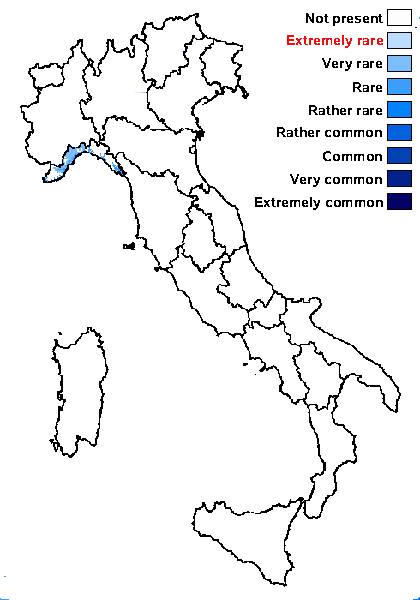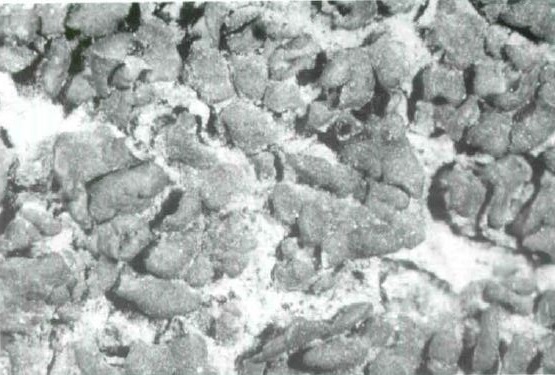Heteroplacidium contumescens (Nyl.) Breuss
Ann. naturhist. Mus. Wien, 98B: 40, 1996. Basionym: Endocarpon contumescens Nyl. - Flora, 61: 341, 1878.
Synonyms: Catapyrenium contumescens (Nyl.) Breuss; Dermatocarpon contumescens (Nyl.) Zahlbr.
Distribution: N - Lig (Alonso & Egea 1994).
Description: Thallus squamulose, of loosely attached, 1-3 mm wide, 0.25-0.4 mm thick, scattered to contiguous, rounded to slightly lobate, flat squamules with deflexed to revolute margins. Upper surface pale to medium brown, matt; lower surface pale brown, attached by colourless, up to 6.5 µm thick rhizohyphae. Upper cortex 25-55 μm thick, paraplectenchymatous, with or without a thin epinecral layer; medulla white in upper part, brownish in lower part, of spherical hyphae; lower cortex not clearly delimited from the medulla. Perithecia black, subglobose, up to 0.4 mm wide, immersed in the squamules, without involucrellum. Exciple pale, darkening with age; paraphyses absent, substituted by 30-40 μm long periphyses; hymenial gel hemiamyloid. Asci 8-spored, clavate, I-, fissitunicate, the wall thickened above, Verrucaria-type, 60-70 x 15-18 µm. Ascospores 1-celled, hyaline, ellipsoid, 11-15 x 5.5-8 µm, biseriately arranged in the asci. Pycnidia laminal, black, immersed, of the Dermatocarpon-type. Conidia oblong-ellipsoid to subcylindrical, 3-4.5 x 1-1.8 µm. Photobiont chlorococcoid. Spot tests: cortex and medulla K-, C-, KC-, P-, UV-. Chemistry: without lichen substances.Note: on steeply inclined to rain-sheltered surfaces of base-rich or calciferous rocks, sometimes on soil in rock fissures, mostly in warm-dry situations, e.g. in grasslands and garrigues; perhaps more widespread in Mediterranean Italy.
Growth form: Squamulose
Substrata: rocks, soil, terricolous mosses, and plant debris
Photobiont: green algae other than Trentepohlia
Reproductive strategy: mainly sexual
Commonnes-rarity: (info)
Alpine belt: absent
Subalpine belt: absent
Oromediterranean belt: absent
Montane belt: absent
Submediterranean belt: very rare
Padanian area: absent
Humid submediterranean belt: absent
Humid mediterranean belt: rare
Dry mediterranean belt: very rare

Predictive model
Growth form: Squamulose
Substrata: rocks, soil, terricolous mosses, and plant debris
Photobiont: green algae other than Trentepohlia
Reproductive strategy: mainly sexual
Commonnes-rarity: (info)
Alpine belt: absent
Subalpine belt: absent
Oromediterranean belt: absent
Montane belt: absent
Submediterranean belt: very rare
Padanian area: absent
Humid submediterranean belt: absent
Humid mediterranean belt: rare
Dry mediterranean belt: very rare

Predictive model
 INDEX FUNGORUM
INDEX FUNGORUM
 GBIF
GBIF


